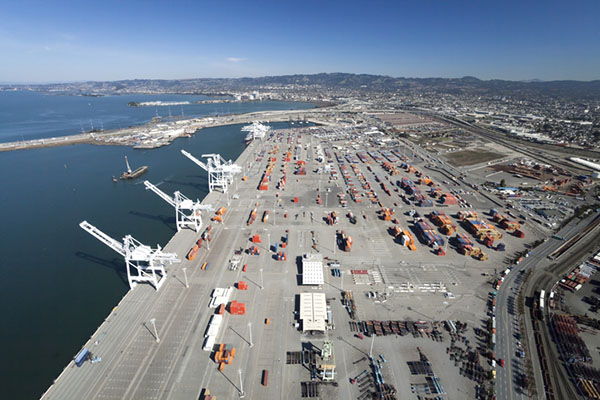Port of Oakland made significant strides in 2018, but there’s no looking back
The Port of Oakland had its busiest November ever for imports in 2018, shattering an 11-year-old record.

While California’s two mega ports in San Pedro Bay have reported record inbound container throughput this fall, the state’s third largest ocean cargo gateway has been no slouch in the department, either.
Indeed, the Port of Oakland had its busiest November ever for imports in 2018, shattering an 11-year-old record. Dockside labor handled the equivalent of 83,364 loaded 20-foot import containers last month. That beat the old November record of 76,902 containers set in 2007. November imports were up 15 percent over the same period in 2017.
As with Los Angeles/Long Beach, the the increase in cargo volume was attributed to continued strong U.S. consumer spending. Spokesmen also noted that importers are rushing cargo into the U.S. in case new tariffs are imposed next year in the ongoing trade war with China.
“We’re encouraged by our latest cargo statistics,” says Port of Oakland Maritime Director John Driscoll. “At the same time, we remain cautious as we approach the new year with uncertainty.”
Total volume—imports, exports and empty containers—was up 5 percent in the first 11 months of 2018. If the trend continues, Oakland would set a new cargo volume record for the third straight year.
Another happy story for Oakland, is that it is winning the battle against global trade headwinds, with scrap paper shipments jumping up 3 percent in the first 10 months of 2018.
The increase in Oakland’s recyclable paper shipments contrasts with a generally challenging environment for U.S. exports. That’s important because waste paper is the largest export commodity, measured by container volume, shipped from Oakland.
“We can’t be certain if this trend will last, but the figures seem to show that there’s no loss of demand globally,” says John Driscoll. “It appears that shippers are finding new markets for their scrap paper products.”
The port shipped the equivalent of 110,400 20-foot containers of wastepaper in 2018 through October. That accounted for nearly 18 percent of Oakland’s total export volume. Port data shows that nearly all the recyclable paper went to Asia. The product is used primarily to make packaging for billions of dollars of Asian goods exported to the U.S.
Scrap paper shipments have increased this year despite trade pressures that include:
- A rising U.S. dollar making American products more expensive overseas;
- The U.S.-China tariff standoff; and
- China’s new, tougher quality standards for foreign scrap products.
China, Oakland’s No. 1 trade partner, has reduced scrap paper shipments from the Port by 37 percent this year. Neighboring Asian countries have picked up the slack. Oakland scrap exports to Taiwan are up 522 percent in 2018 with shipments to Vietnam up 344 percent.
Scrap metal exports have increased 10 percent in 2018. It said that shipments of the commodity to China have slumped 43 percent. That loss has been largely offset by increased shipments to Taiwan, Vietnam and India.
Driscoll will be briefing Bay Area shippers in Oakland’s annual “State of the Port” address next month in Jack London Square. According communication’s director, Mike Zampa, the talk will largely focus on how the port will implement the 5-year strategic plan announced last year.
“The plan will position us for even more growth,” says Zampa, “and logistics managers are eager to learn the details.”

Article Topics
Ports News & Resources
U.S.-bound import growth track remains promising, notes Port Tracker report Q&A: Port of Oakland Maritime Director Bryan Brandes Signs of progress are being made towards moving cargo in and out of Baltimore New Breakthrough ‘State of Transportation’ report cites various challenges for shippers and carriers in 2024 Industry experts examine the impact of Baltimore bridge collapse on supply chains Port of Baltimore closed indefinitely to ships after 1.6-mile Key Bridge collapses following maritime accident February and year-to-date U.S. import growth is solid, reports S&P Global Market Intelligence More PortsLatest in Logistics
LM Podcast Series: Assessing the freight transportation and logistics markets with Tom Nightingale, AFS Logistics Investor expectations continue to influence supply chain decision-making The Next Big Steps in Supply Chain Digitalization Warehouse/DC Automation & Technology: Time to gain a competitive advantage The Ultimate WMS Checklist: Find the Perfect Fit Under-21 driver pilot program a bust with fleets as FMCSA seeks changes Diesel back over $4 a gallon; Mideast tensions, other worries cited More LogisticsAbout the Author
Subscribe to Logistics Management Magazine

Find out what the world's most innovative companies are doing to improve productivity in their plants and distribution centers.
Start your FREE subscription today.
April 2023 Logistics Management

Latest Resources














